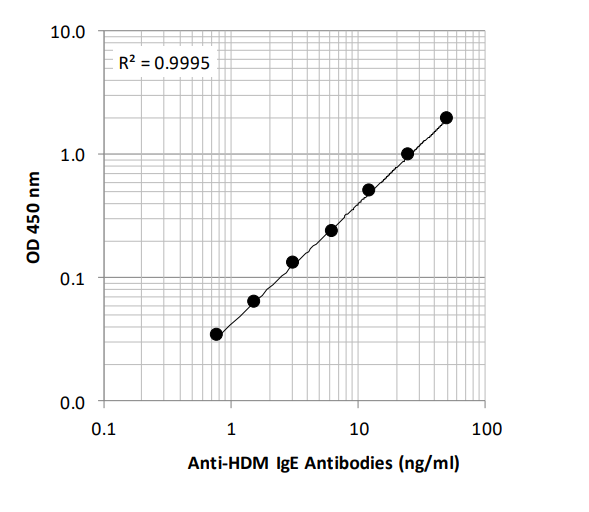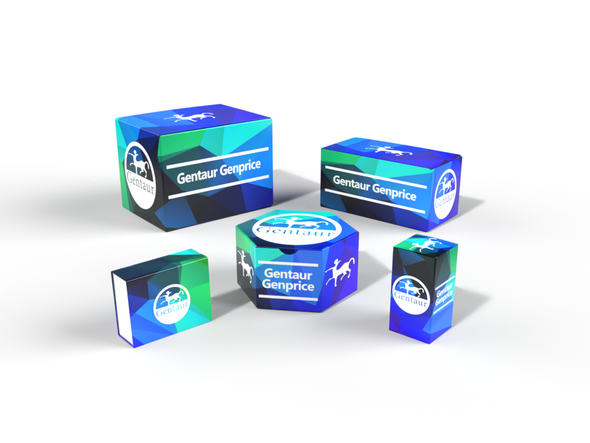445
Mouse Anti-House Dust Mite (HDM) IgE Antibody Assay Kit
- SKU:
- 445-3037-GEN
- Availability:
- IN STOCK
Description
Mouse Anti-House Dust Mite (HDM) IgE Antibody Assay Kit - Cat Number: 3037 From .
Research Field: Allergy, Immunology
Clonality: N/A
Cross-Reactivity:
Host Origin: N/A
Applications: N/A
Isotype: N/A
Detection Range: 50 ng/ml-0.78 ng/ml
Sample Type: Serum, Plasma
Concentration: N/A
Immunogen:
DESCRIPTION: ELISA kit to quantify mouse anti-house dust mite IgE antibodies
FORMAT: Precoated 96-well ELISA Plate with removeable strips
ASSAY TYPE: Sandwich ELISA
ASSAY TIME: 5 hours
STANDARD RANGE: 50 - 0.8 ng/ml
NUMBER OF SAMPLES: Up to 40 (duplicate) samples/plate
SAMPLE TYPES: Serum & Plasma (pre-treatment acceptable)
RECOMMENDED SAMPLE DILUTIONS: 1:10 (at least)
CHROMOGEN: TMB (read at 450 nm)
STORAGE: -20°C for 12 months
VALIDATION DATA: Intra-Assay (1.7-5%)/Inter-Assay (3.2-5.3%)/Spiking Test (90-103%)
INTRODUCTION
Asthma is a common chronic inflammatory disease that affects 300 million people of all ages worldwide (1). It is caused by exposure to allergens such as dust mites, pet dander, pollen, or mold, and characterized by airflow obstruction and bronchospasm. House dust mite (HDM) is the most common asthma allergen, which affects up to 85% of asthma patients (2, 3). Of the two main mite species, Dermatophagoides pteronyssinus (Der p) and Dermatophagoides farinae (Der f), more than 20 types of HDM allergens are defined based on sequential and functional homologies. Among those HDM allergens, group 1 (Der 1) and group 2 (Der 2) dominate overall allergic responses in patients and are the most researched allergens (4-6).
Previously, asthma was considered an inflammatory airway disease mediated by the adaptive immune system, particularly type 2 helper Tcells (7). However, recent studies indicate that the innate immune system is also involved in triggering an inflammatory response in both asthma patients and animal models (8-10). Airway remodeling and inflammatory changes significantly vary depending on the types of allergens (11). To meet such needs, a mouse HDM-induced asthma model is a useful tool to dissect the pathological roles of the adaptive and innate immune systems activated by the different HDM elements. This is an advantage over the classical ovalbumin-induced asthma model which preferentially activates adaptive immunity.Recently, it was reported that HDM-specific sublingual immunotherapy (SLIT) is more efficacious at preventing the development of allergic inflammatory reactions than subcutaneous immunotherapy in mouse models (12).
This SLIT protocol has been approved as a treatment to reduce allergy or asthma symptoms in patients (13). In general, mouse serum antigen-specific antibody levels for antibodies like IgA and IgG tend to be higher than IgE levels. Thus, it is difficult to detect antigen specific IgE antibody levels due to the competition for the antigenic determinant on the antigen by other types of antibodies. This kit is designed to detect HDM specific IgE antibodies in mouse serum and works for both IgEa (Balb/c) and IgEb (C57BL/6) allotypes equally. To study the immune response to allergens and allergen-specific pathological effects in mouse models, , Inc.
provides mouse ELISA kits for assaying anti-HDM antibodies., Inc. also offers ELISA kits for assaying anti-OVA antibody subtypes/subclasses as well as total immunoglobulin subtypes/subclasses. Please visit www..com for more information. Note: Other antibody subtype ELISA kits against HDM as well as HDM antigen detection kits are currently under development. Please contact , Inc. support (support@.com) for more information
PLATE MAPPING
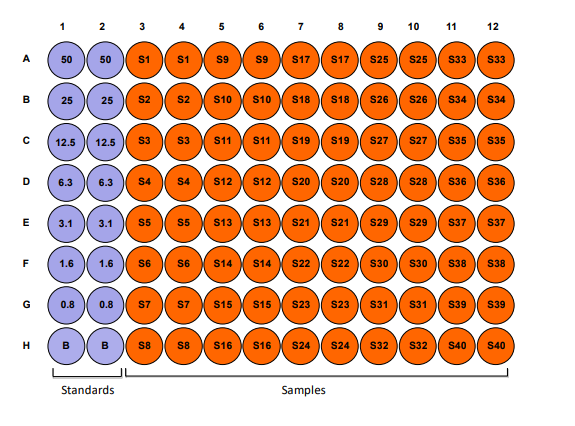
KIT COMPONENTS
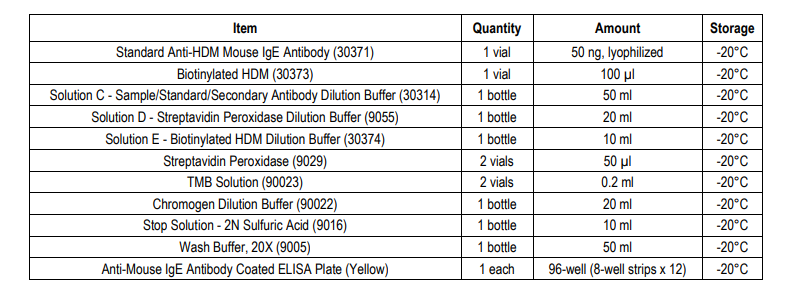
ASSAY OUTLINE
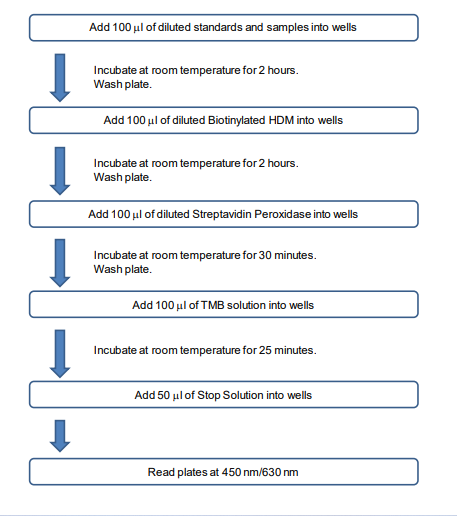
NOTES BEFORE USING ASSAY
NOTE 1: It is recommended that the standard and samples be run in duplicate.
NOTE 2: Warm up all buffers to room temperature before use.
NOTE 3: Crystals may form in Wash Buffer, 20X when stored at cold temperatures. If crystals have formed, warm the wash buffer by placing the bottle in warm water until crystals are completely dissolved.
NOTE 4: Measure exact volume of buffers using a serological pipet, as extra buffer is provided.
NOTE 5: Cover the plate with plastic wrap or a plate sealer after each step to prevent evaporation from the outside wells of the plate.
NOTE 6: For partial reagent use, please see the assay protocol’s corresponding step for the appropriate dilution ratio. For example, if the protocol dilutes 50 µl of a stock solution in 10 ml of buffer for 12 strips, then for 6 strips, dilute 25 µl of the stock solution in 5 ml of buffer. Partially used stock reagents may be kept in their original vials and stored at -20⁰C for use in a future assay.
NOTE 7: This kit contains animal components from non-infectious animals and should be treated as potential biohazards in use and for disposal.
NOTE 8: Serum IgE antibodies are a mixture of multiple antibodies with a variety of affinity ranges. The OD value obtained in ELISA for an antibody assay depends on the antibody concentration as well as the antibody affinity towards an antigen. In general, ELISA data using a monoclonal antibody as a standard does not reflect the absolute levels of IgE. Therefore, IgE levels determined using this kit should be expressed as ng of IgE per ml.
NOTE 9: If the total IgE concentration in a sample is higher than 500 ng/ml, the sample must be diluted to lower the total IgE levels below 500 ng/ml because the anti-HDM IgE value obtained from this ELISA is lower than the actual value due to competition from non-anti-HDM IgE antibodies in sample (Figure 2). Therefore, it is strongly recommended that total IgE levels be determined first using the Mouse Total IgE Assay Kit (Catalog # 3005).
ASSAY PROCEDURE
1. Prepare Standard Dilutions: The recommended standard range is 0.8 - 50 ng/ml. Dissolve one vial of Standard (50 ng/vial) in 1 ml of Sample/Standard/Secondary Antibody Dilution Buffer (Solution C) and keep it as a standard stock. Then serially dilute it with Solution C. For example, mix 250 µl of the 50 ng/ml solution with an equal volume of Solution C to make a 25 ng/ml solution, and then repeat it five more times for 12.5, 6.3, 3.1, 1.6, and 0.8 ng/ml standard solutions.

Prepare Sample Dilutions: The dilution of mouse serum immunized with HDM will vary (1:10 or more) depending on the immunization schedule and timing of serum collection. In general, no IgE antibodies against HDM are observed in normal serum at a 1:10 dilution.
3. Add Standards and Samples: Add 100 µl of standards, Solution C (blank), and samples to wells in duplicate. Incubate at room temperature for 2 hours.
4. Wash: Dilute 50 ml of 20X wash buffer in 950 ml of distilled water (1X wash buffer). Wash the plate with 1X wash buffer at least 3 times using a wash bottle with manifold or an automated plate washer. Empty the plate by inverting it and blotting on a paper towel to remove excess liquid. Do not allow the plate to dry out.
5. Add Biotinylated HDM: Dilute one vial of biotinylated HDM in 10 ml Biotinylated HDM Dilution Buffer (Solution E). Add 100 µl of biotinylated HDM solution to each well and incubate at room temperature for 2 hours.

8. Wash: Wash the plate with 1X wash buffer at least 3 times using a wash bottle with manifold or an automated plate washer. Empty the plate by inverting it and blotting on a paper towel to remove excess liquid. Do not allow the plate to dry out.
9. Add TMB Solution: Use new tubes when preparing TMB solution. Just prior to use, prepare TMB solution with Chromogen Dilution Buffer as shown in the following table. Add 100 µl of TMB solution to each well immediately after washing the plate and incubate for 25 minutes at room temperature

CALCULATING RESULTS
1. Average the duplicate OD values for the standards, blanks (B), and test samples.
2. Subtract the averaged blank OD values from the averaged OD values of the standards and test samples.
3. Plot the OD values of the standards against the ng/ml of antibody standard. Using a log/log plot will linearize the data. Figure 1 shows an example of a standard curve for anti-HDM IgE antibodies.
4. The ng/ml of antibody in test samples can be calculated using regression analysis. Multiply it by the sample dilution factor to obtain the antibody concentration (ng/ml) in the original test samples
Figure 1 - A Typical Standard Curve for the Anti-HDM IgE Antibody ELISA Kit
